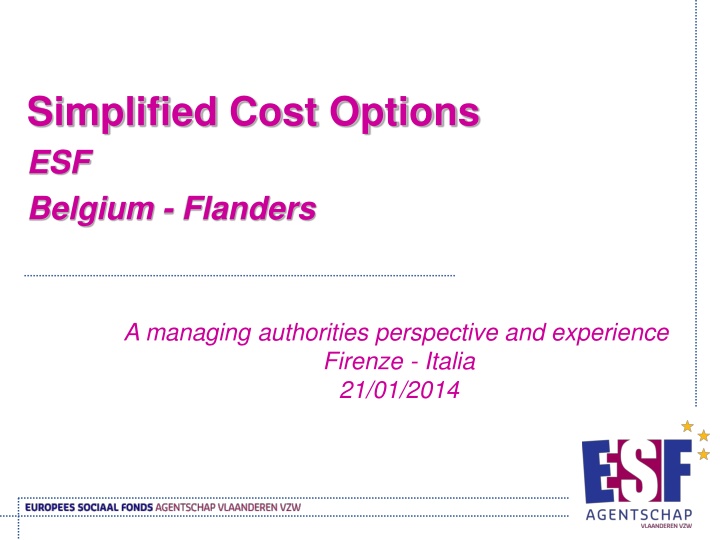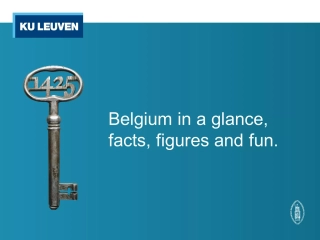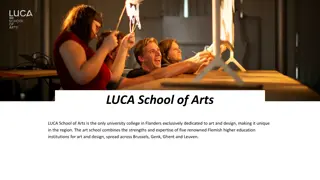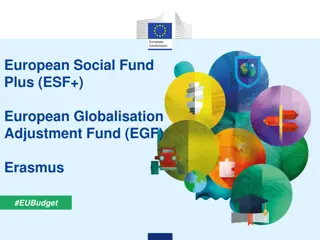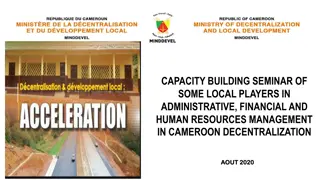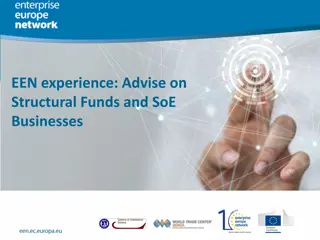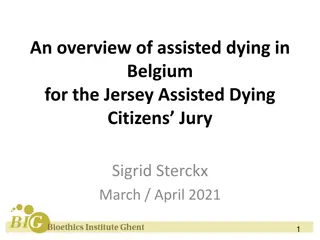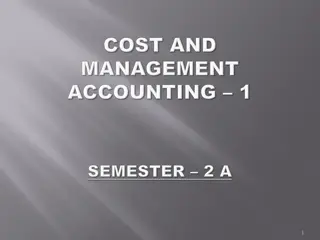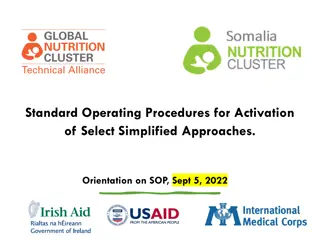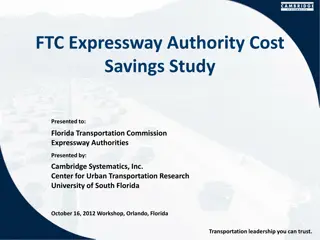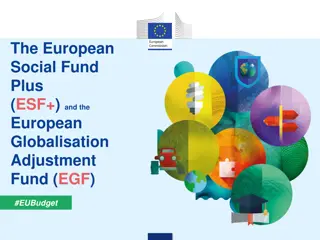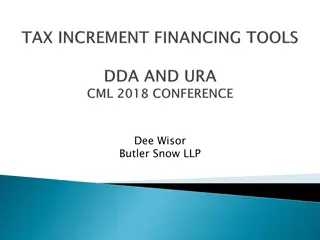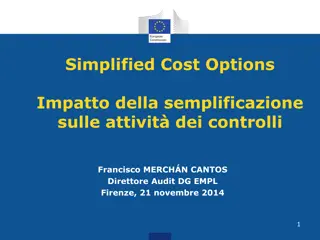Simplified Cost Options for ESF Belgium-Flanders Managing Authorities
This content delves into the perspectives and experiences of managing authorities in Belgium-Flanders regarding simplified cost options for ESF projects. It discusses the benefits, implementation methods, risks, experiences, and future considerations, offering valuable insights for effective financial management in EU-funded projects.
Download Presentation

Please find below an Image/Link to download the presentation.
The content on the website is provided AS IS for your information and personal use only. It may not be sold, licensed, or shared on other websites without obtaining consent from the author.If you encounter any issues during the download, it is possible that the publisher has removed the file from their server.
You are allowed to download the files provided on this website for personal or commercial use, subject to the condition that they are used lawfully. All files are the property of their respective owners.
The content on the website is provided AS IS for your information and personal use only. It may not be sold, licensed, or shared on other websites without obtaining consent from the author.
E N D
Presentation Transcript
Simplified Cost Options ESF Belgium - Flanders A managing authorities perspective and experience Firenze - Italia 21/01/2014
Agenda 1. Why - Benefits 2. How - Flat rates & 3 P model 3. How - Standard scales & 4 examples 4. How - Lump sums 5. Risks 6. Experiences 7. Future use 8. Considerations for MA/IB
Why Final beneficiaries: reduce administration no more collection and archiving of every (small) cost no more discussion whether or not costs are linked to the project no more discussing about the allocation of a % to the project no more trouble about the privacy of documents like salary sheets legal certainty as a basis for a good partnership
Why ESF-Agency (MA-CA-AA) Easy to communicate and to control Less time consuming, so more time to develop - monitor support content and results of projects and programmes In general, the financial management and control becomes simple mathematic Unit or result X agreed cost/unit Contribute to a better partnership More emphasis on Results Better Partnership Correcter and more focused Spending Compliance easier to fulfill
Agenda 1. Why - Benefits 2. How - Flat rates & 3 P model 3. How - Standard scales & 4 examples 4. How - Lump sums 5. Risks 6. Experiences 7. Future use 8. Considerations for MA/IB
How - flat rates STEP 1 - Checking 2000-2005 payments on % indirect costs Variation between 12% - 23%, depending the nature of projects STEP 2 : Checking definition of (in)direct costs used in the past Cleared definition of (in)direct costs using the 3 types of process model for the future
How - flat rates STEP 3 - comparing priorities OP 2000-2006 with priorities OP 2007-2013 Findings 2000-2006: Projects on unemployment: 22% indirect costs Adaptability of workers & enterprises: 12-17% Innovation: 15-16% Transnationality: 15-17%
How - flat rates STEP 4 - decision of Flemish Monitoring Committee Clear definition of eligibility and nature of costs: every cost linked with the tertiary process is indirect Defining two percentages in relation to Flemish OP Unemployment Other priorities Applicable percentage to be included in every call for proposals Possibility to vary per call for proposals on a motivated basis 20% 15%
How flat rates STEP 5 - Letter explaining system to the EC, DG Employment, approval received STEP 6 - Immediate application of percentages in all calls for proposals of the OP 2007-2013 STEP 7 - System in evaluation by external evaluator
STEP 2 3 P(rocesses) Model Dynamic approach of structuring organisations 3 main processes Client perspective
3 P-model Primary processes The hart of the matter, core business They show the transformation of input in output The process that delivers the contract f.i. evaluation What a client sees directly and pays for Is related to the mission of an organisation
3 P-model Secundary processes Direct support for the core Specialised processes that are to be considered as subprocesses of the primary processes Clients can judge the quality and accepts paying for them supportive actions to enable contractor to deliver the result and the qualitative content requested (survey)
3 P-model Tertiary processes Necessary to support, facilitate the other two processes What has to be included in the price, but of no intrest to client accompanying actions/measures/conditions to be able to deliver (management, administration, utilities, )
3 P-model Check 3P against objective(s) of every call for projects Determines the primary process of the projects F.i. communication
Agenda 1. Why - Benefits 2. How - Flat rates & 3 P model 3. How - Standard scales & 4 examples 4. How - Lump sums 5. Risks 6. Experiences 7. Future use 8. Considerations for MA/IB
How - standard scales of unit costs STEP 1 - define the nature of the requested projects/operations in the call STEP 2 Check the historical data (real costs) on similar projects/operations OR Look for possible benchmarks PES, education system, other experiences IMPORTANT : be your own devils advocate
How standard scales STEP 3 - decision of Flemish Monitoring Committee In principle we work with standard costs, preferably for the whole project except trainees salaries or activated social benefits If needed the standard cost applies to some costs like for instance staff, others can be real costs, indirect costs always on flat rate Only if there are NO data (historical or benchmarks) to justify a standard cost we use the real costs system for direct costs
Examples Standard scales A. Training of workers B. Career guidance C. Innovation D. Transnationality
Standard scales - Training of workers STEP 1a - We checked recent available data of similar finalised projects including intermediary reports and calculated a cost per trainee/hour (without trainees salaries) STEP 1b -We checked recent approvals of similar projects STEP 1c - We checked evolutions in costs per trainee/hour from original applications to final payment claims Cost driver
Standard scales - Training of workers Decision: Checking data from 2005 till 2010 resulted in an evolution of staff costs and direct cost from 11,47 in 2005 to 18,38 in latest approvals Taken into account the average and the evolution of the index we decided to go for 15 for staff and direct costs We added the percentage for indirect costs (15%) Final result : 15 + 2,25 = 17,25 per trainee/hour This was included in the call and project contracts
Standard scales Career guidance STEP 1 - We calculated price per person of the final payment claims of the available data (2005- 2009) from similar calls/projects STEP 2 - We checked Flemish legislation on accepted maximum costs RESULT - We compared the data and decided on the costs for the first 500 persons in a project and a lower price on the surplus Cost driver
Standard scales Innovation STEP 1 - cost driver = staff cost STEP 2 - Because every project has a different nature and needs other competences We defined different competence levels that have been used in former projects junior and senior staff and project leaders Supporting junior and senior staff We checked the average salary (as) in the public service for such competences (0-5y, 6-10y, +)
Standard scales Innovation STEP 3 - we checked the average staff costs and the average direct costs (dc) paid for in past years to similar projects STEP 4 - we calculated the level of direct costs as a percentage of the staff costs If staff=100 and direct cost=11 then dc=11% STEP 5 - we applied this percentage on every level of competence and added the two up STEP 6 - this sum was multiplied by 15% for indirect costs
Standard scales Innovation RESULT : Total standard cost to be used for every member of staff that is needed in the project according to the agreed project work plan = (AS + DC) + (AS+DC)X15%
Standard scales Transnationality Because every project has a different nature and needs other competences, we took following steps We defined different competence levels that have been used in former projects junior and senior staff and project leaders Supporting junior and senior staff We checked the average salary (as) in the public service for such competences (0-5y, 6- 10y, +)
Standard scales Transnationality STEP 1 - cost driver = staff cost STEP 2 - Because every project has a different nature and needs other competences We defined different competence levels that have been used in former projects junior and senior staff and project leaders Supporting junior and senior staff We checked the average salary (as) in the public service for such competences (0-5y, 6-10y, +)
Standard scales Transnationality STEP 3 - We foresee different types of projects (import/export), and we don t have enough relevant data (historic nor benchmark) => we apply the real costs for the direct cost as well as for the transnational costs STEP 4 -The indirect costs are a flat rate of 15% of the sum of staff costs, direct costs and transnational costs
Agenda 1. Why - Benefits 2. How - Flat rates & 3 P model 3. How - Standard scales & 4 examples 4. How - Lump sums 5. Risks 6. Experiences 7. Future use 8. Considerations for MA/IB
How - Lump sums STEP 1 - define the nature of the project/operation and the result wanted STEP 2 - define a detailed list of items/actions that appear in a reasonable budget STEP 3 - Check historical data or look for benchmarks in public and private sector for the whole and for each item if possible
Lump sum - Transnationality STEP 1 - the preparatory phase is limited in time and has clearly defined actions, goals and results (i.e. 3 months, desk research, define scoop of project and baseline study) STEP 2 - through benchmarks we defined the needed staff as junior academic level and check this with the average salary in the public service STEP 3 - we added necessary working costs and indirect costs RESULT - lump sum of 11.000
Lump sum - transnationality Where peer review is needed and accepted at the grant decision, we use the lump sum Again data check and benchmarks learned us that following elements are needed: People presenting the product(s), seminar package, moderator and rapporteur The price was set after a benchmark and our own experiences at 10.000 and the report is needed
Agenda 1. Why - Benefits 2. How - Flat rates & 3 P model 3. How - Standard scales & 4 examples 4. How - Lump sums 5. Risks 6. Experiences 7. Future use 8. Considerations for MA/IB
Risks All risks are for the managing authority/intermediary body/executive promoter that defines the system in its calls for projects, no legal certainty until audit Difference standard costs standard financing. The additionality principle stills stand in financing a project/operation. So first deduct income and the national/regional/local/ co financing money and only the rest is ESF Increased importance of registration of activities Retention of documents at MA/IB and or project beneficiary
Agenda 1. Why - Benefits 2. How - Flat rates & 3 P model 3. How - Standard scales & 4 examples 4. How - Lump sums 5. Risks 6. Experiences 7. Future use 8. Considerations for MA/IB
Experiences Flat rates: Applied in ALL calls since 2007 Very much welcomed by beneficiaries although some loose money Standard scales: Gradually applied since 2009 Welcomed by project promoters after a first hesitation due to references used (public service)
Experiences Lump sums: Applied in all calls on Transnationality from 2010 on Applauded by project promoters because of clear definition of result wanted, reasonable level and simple application of the system All: Clear communication and training is needed, not only for project promoters, also auditors Changing the mind-set around costs/subsidies/profit was th internal trick
Agenda 1. Why - Benefits 2. How - Flat rates & 3 P model 3. How - Standard scales & 4 examples 4. How - Lump sums 5. Risks 6. Experiences 7. Future use 8. Considerations for MA/IB
Future use Evaluate current practice and where needed amend it Establish Flemish regulation with SCO where possible Public procurement where possible Salary plus 40% when caseload can be defined, including simplifying definition of salary
Future use Lump sum for specific operations with clear targets and clearly definable and realistic results Simplifying administration through clear instructions on registration and documentation On going information and training of staff, AA and final beneficiaries
Agenda 1. Why - Benefits 2. How - Flat rates & 3 P model 3. How - Standard scales & 4 examples 4. How - Lump sums 5. Risks 6. Experiences 7. Future use 8. Considerations for MA/IB
1. Real simplification for MA and or IB? YES for the total functioning of the programme and projects, BUT Ex ante a call for proposals MA or IB needs to invest a lot of time concerning: examining, calculating and documenting the product or result required, criteria and indicators to use, check availability of historical data on cost driver, define the SCO method used Define the documentation (registration) required from final beneficiaries Determine how thing will be controlled
1. Real simplification for MA and or IB? Keep in mind that there is a difference between standard costs standard financing. The additionality principle still stands and it is a fact that the Funds can not participate in overfinancing a project/operation Follow up how state aid and public procurement relate to the SCO s used and how this will be controlled Follow closely the delegated acts on the subject
2. From controller to supporter Result based programmes demand another implementation mode from MA/IB Role of MA/IB has to evolve towards a partner who helps others to realise results Starting point is the call for projects, Monitoring becomes a supporting action MA is not the specialist on every issue concerning labour market or employment policy, but has to be a FACILITATOR and has to be an inspiring coach
3. Impact on final beneficiaries Easy to calculate the results and finances needed for a project Easy financial management and archiving (digitalize!) Need for clear reporting on results and or activities performed Possible problems: Documentation/Registration of results and or activities Performance audits Retention of documents at MA/IB and or project promoter
4. Reducing risks and errors Starts with call for proposals where there is a need for clear definitions of: results wanted indicator(s) to be used flat rate, standard cost and or lump sum good documentation on what legal basis for SCO is used where necessary, how SCO are calculated Describe and use a simple but effective registration system (from basic documents up until IT system) guaranteeing the four eyes principle Digitalize all documentation Develop and train final beneficiaries in self evaluation, Danger that monitoring and interim reporting becomes pure controll
5. Committing ESF and ERDF funds more quickly Since finances become more transparent, processing and approvals for engagements and or payment requests go much faster Better for realizing n+2 or n+3 Easier closures, perhaps even annual
6. Other benefits For final beneficiaries: MA/IB becomes a trustworthy partner Auditing becomes a performance audit and no longer a financial one Audit can only be on results achieved and or activities performed Audit should be less time consuming
6. Other benefits For MA or IB: Clearer and better results on the labour market, rise in value for money More entrepreneurial challenges Easier management of programmes Easier reporting to Mon Com and or EC
Advice Change the mind-set around costs/profits/subsidies into subsidies/results at a fair price Involve all partners in developing and implementing SCO s Be transparent in your communication on why what how Provide training for all stakeholders
